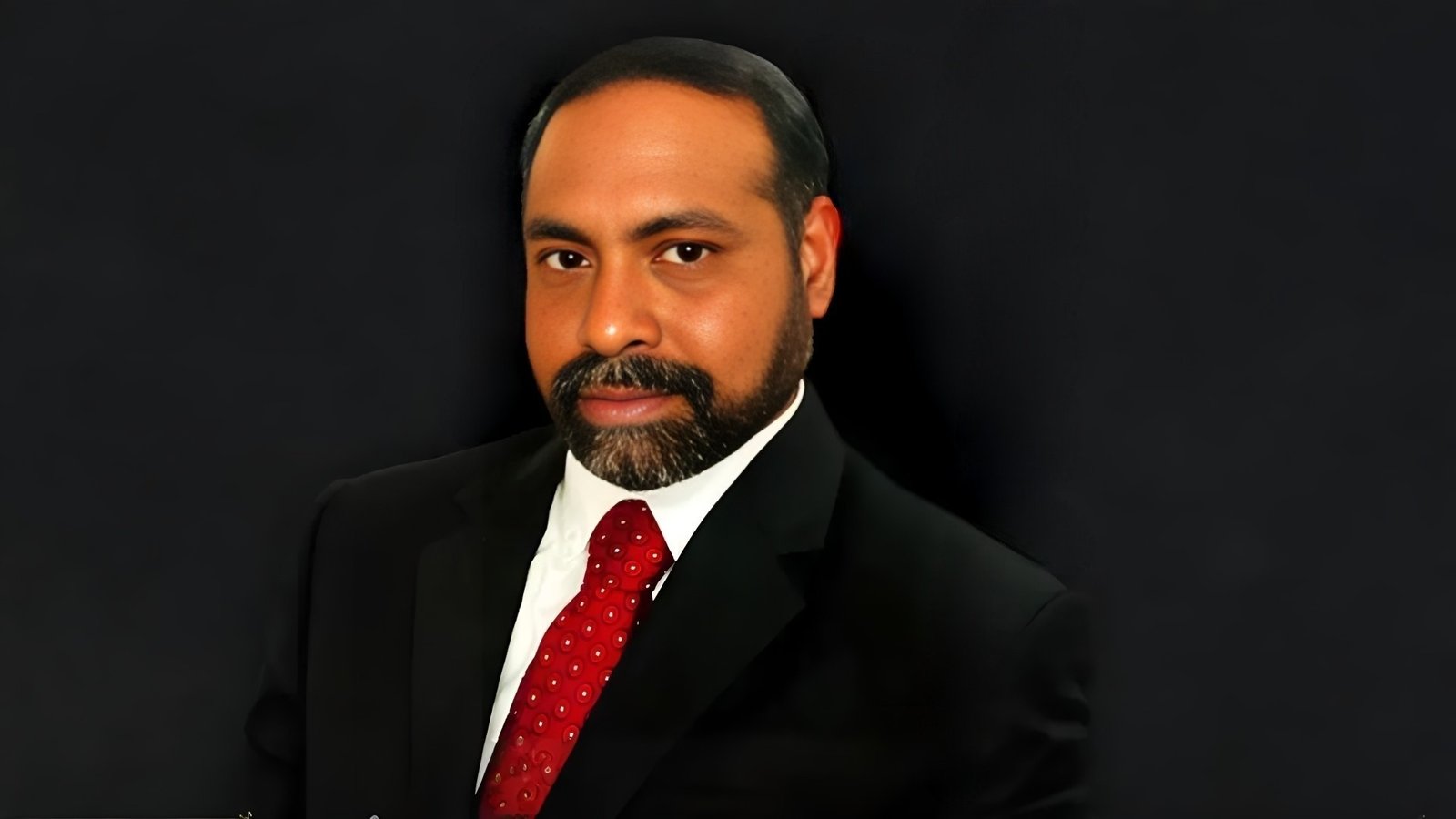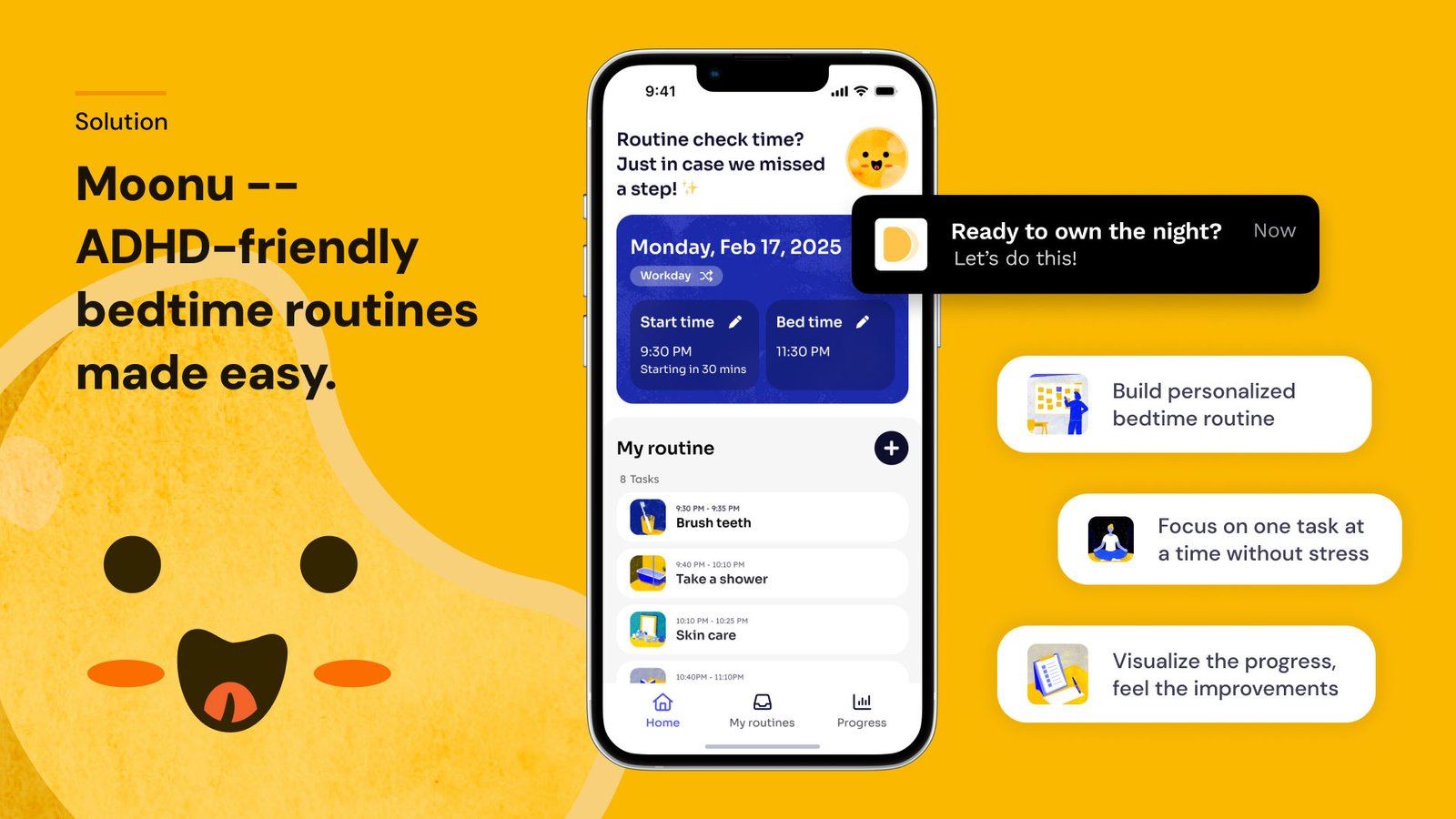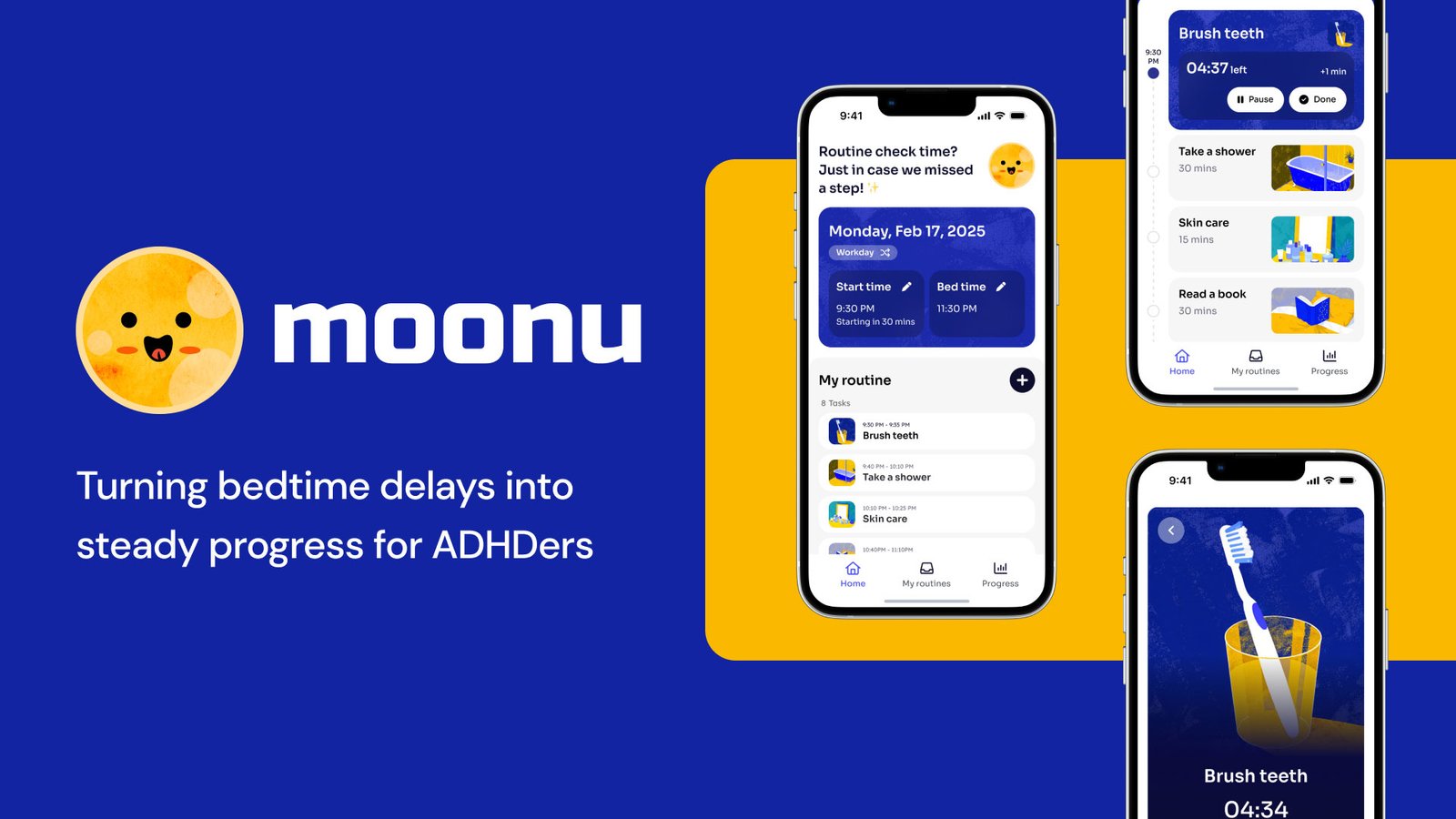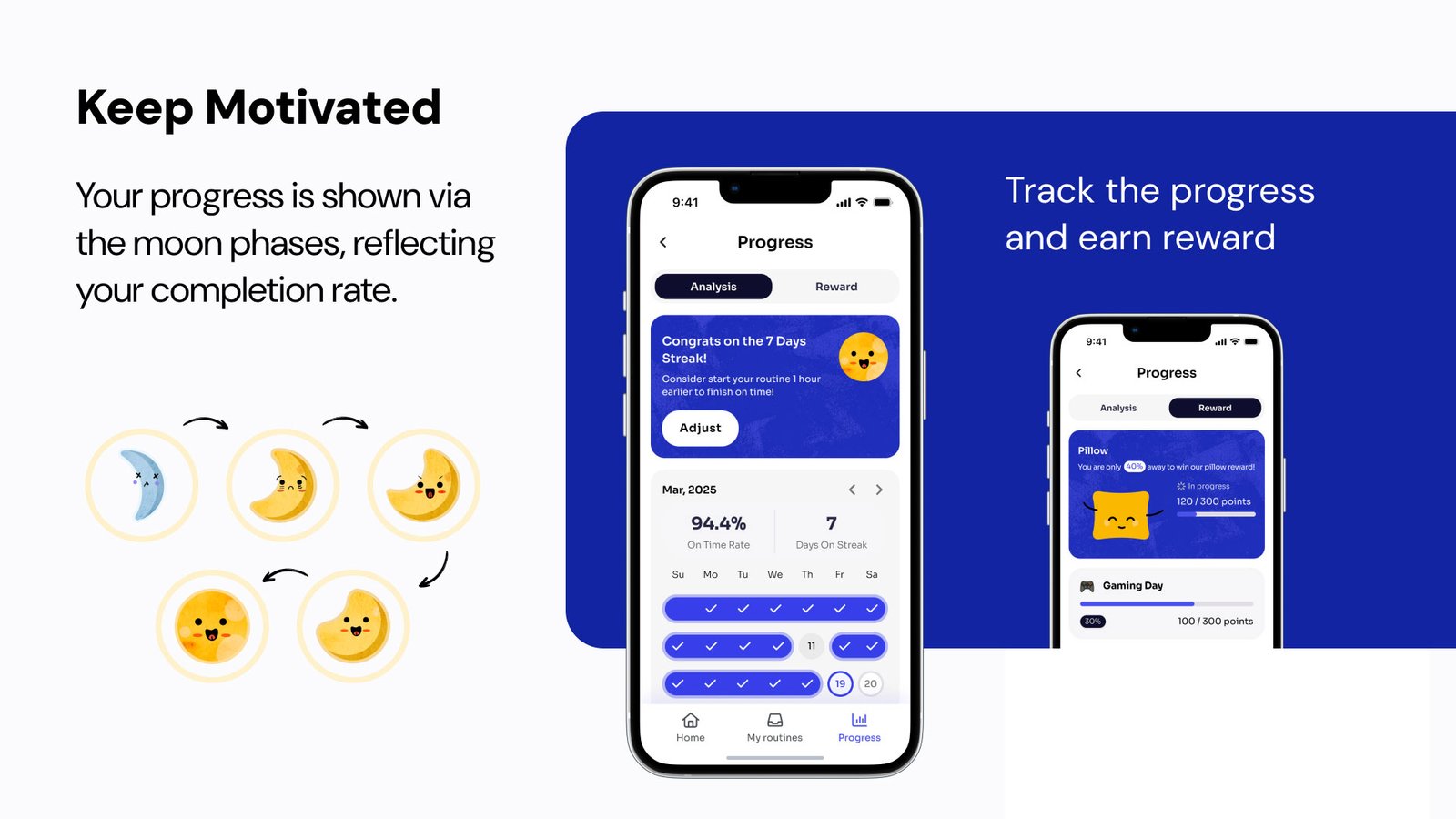
Lightsabers, Kickstarter & Cardboard: The Creative Path of Ori Kagan
May 19, 2025
Building Smarter Systems: An Interview with Sasibhushan Rao Chanthati
May 19, 2025
Lightsabers, Kickstarter & Cardboard: The Creative Path of Ori Kagan
May 19, 2025
Building Smarter Systems: An Interview with Sasibhushan Rao Chanthati
May 19, 2025Xiaochen Shi, Yi Cui & Yuan Wu
The Moonu team consists of Xiaochen Shi, Yi Cui, and Yuan Wu, who bring together backgrounds in urban planning, creative problem-solving, and inclusive design to craft meaningful, human-centered experiences. They created Moonu, an app that transforms bedtime delays into steady progress for people with ADHD by combining clarity, empathy, and creativity.
Xiaochen: Thank you! I'm Xiaochen, a product designer with a background in urban planning and a passion for turning complex systems into simple, meaningful experiences. What inspired me to pursue design was realizing how much impact design has on the way people interact with the world—both physically and digitally.
In urban planning, I often found it hard to validate ideas until things were built, but product design gave me the agility to test, learn, and iterate quickly. That ability to connect with real users, solve real problems, and keep improving is what drew me in—and it’s what continues to excite me every day.
Yi: I'm Yi, a product designer with a deep interest in how thoughtful design can quietly improve everyday life. What inspired me to pursue design was the realization that good design often goes unnoticed—but it makes things feel easier, clearer, and more human.
I’ve always enjoyed solving problems in creative ways, and design became the space where I could bring that instinct to life—through both visuals and interactions. Over time, it became not just a career, but a way to connect with people and make meaningful experiences.
Yuan: Hi, I’m Yuan Wu, a product designer with a deep passion for creating inclusive, human-centered experiences. What inspired me to pursue design was the realization that thoughtful, intentional design can break down barriers and empower people—especially those who are often overlooked by conventional systems.
For me, design goes beyond aesthetics; it’s about creating solutions that reduce friction, amplify voices, build emotional trust, and improve everyday life through empathy. The ability to make a meaningful impact and contribute to positive change is what continuously drives me in my career.
Being recognized by the NY Product Design Awards means a great deal to us. It’s both encouraging and reflective of our work. As designers, we spend so much time iterating, listening, and refining behind the scenes, and with only 8 images in the submission, we feared that our work might not speak for itself.
This recognition serves as a reassuring reminder that people do see the value in what we create, and that it can truly make a positive impact. It also reinforces our commitment to human-centered design and motivates us to continue building experiences that genuinely serve people.
The award has given our three-person team instant credibility. It raised awareness of Moonu, sparked interest from potential research partners and investors, and opened doors for conversations with companies that can help us scale. Inside the studio, the recognition boosted morale, clarified our roles, and enhanced our collaboration, allowing us to ship updates faster.
This achievement has not only validated our approach but also opened up new avenues for growth and collaboration.
Experimentation is at the heart of our creative process. It’s how we uncover intuitive, human-centered design solutions. Rather than adhering to a fixed formula, we embrace early-stage testing and exploration—even if the ideas feel unconventional.
For example, during the design of Moonu, an app for individuals with ADHD, we experimented with various onboarding flows and visual systems. One unexpected discovery was the effectiveness of playful, pattern-based animations to guide users. These animations helped reduce cognitive load and made the experience more engaging. Insights like this come from testing, observing, and iterating—constantly refining our approach based on real feedback.
An unusual (and personal) source of inspiration came from our own experiences with the struggle to go to bed on time. We realized that many people face this challenge, often stuck in a late-night loop of scrolling, overthinking, or avoiding their bedtime routine altogether.
This reflection led to the creation of an ADHD bedtime routine app. We wanted to design something that was gentle, encouraging, and structured—something that we personally would have appreciated in those moments. This experience reminded us that the most meaningful design ideas often emerge from our own struggles and the everyday challenges we face quietly.
One key point we wish more people understood is that great design isn’t just about aesthetics; it’s about how things work for real users. The design process is deeply iterative, requiring time, feedback, and constant rethinking to arrive at something that feels simple and intuitive.
For instance, with Moonu, we went through multiple rounds of testing to refine the tone and flow for users with ADHD. The seemingly effortless final product was the result of countless small decisions, tests, and adjustments—each one aimed at making the experience truly work for the people we designed it for.
In our case, we don’t have traditional clients. Instead, we design for our users. While we may have clear ideas about what we want to create, we always focus on listening to our users’ needs and behaviors. It’s a constant balancing act—integrating our vision with real-time feedback.
With Moonu, for example, we had a clear vision for a flexible, calming experience, but we adjusted the details—like interaction patterns and tone of voice—based on how users with ADHD responded. Staying true to our values doesn’t mean being rigid; it’s about creating something that genuinely meets the needs of those we’re building for.
One of the biggest challenges we encountered while designing Moonu was striking the right balance between structure and flexibility. People with ADHD often find rigid systems overwhelming, but they also benefit from clear guidance. We didn’t want the app to feel like another stressful to-do list or a source of pressure.
To overcome this, we conducted interviews with people with ADHD, reflected on our own routines, and tested different ways to present tasks. We introduced soft nudges, visual progress markers like a moon character, and calming interactions that supported users without overwhelming them. It was a constant process of listening, adapting, and reminding ourselves that success doesn’t always look linear—our design needed to reflect that.
Xiaochen: The most useful way of recharging for me is talking to people with different backgrounds—friends in non-design fields, former teammates, or even strangers at events. Hearing how others think, work, or approach problems often gives me a fresh perspective and helps me see beyond my usual patterns.
Those conversations remind me that good design isn’t just about trends or tools—it’s about understanding people. And reconnecting with that always helps spark new ideas.
Yi: We step away. Sometimes the best ideas come when we’re not trying too hard—going for a walk, chatting about something unrelated, or even playing around with a different medium helps reset our minds.
As a team, we also like to bounce ideas off each other without pressure. Just hearing a different perspective or seeing someone else sketch something out can spark a fresh direction. Creativity isn’t always linear—so we try to stay open, curious, and playful.
Yuan: When I hit a creative block, I find that stepping away from the screen is often the most effective way to recharge. I like to take a walk or engage in a completely different activity, like reading or listening to music.
I’ve found that shifting my focus allows my mind to reset, and when I return to the project, I often see things from a fresh perspective. It’s during these moments of disconnect that ideas seem to flow more naturally.
Xiaochen: One personal value I always bring into my designs is clear and effective communication. I grew up in a culture where people tend to cut to the point, and that shaped how I think about both visual and interaction design—prioritizing clarity, removing unnecessary friction, and making sure every element has a purpose.
Whether I’m designing a complex workflow or writing microcopy, I aim to help users quickly understand what they need to do without feeling overwhelmed. To me, good design respects people’s time and attention.
Yi: Empathy and curiosity shape a lot of our work. One of our teammates has ADHD, which gave us a more personal understanding of the everyday challenges people face with routines and focus. That experience became a key part of how we approached Moonu—we wanted it to feel supportive, not overwhelming.
We also value simplicity, but not in a minimal-for-the-sake-of-it way. It’s about clarity, kindness, and making things feel approachable. We try to design with care—both in how things look and how they make people feel.
Yuan: I believe that empathy and inclusivity are at the core of my design process. Growing up, I was always keenly aware of how products and services could either empower or exclude people. In my work, I aim to design experiences that feel accessible to everyone, especially those who are often overlooked.
I take inspiration from real-world challenges—like how people with ADHD engage with digital tools—and incorporate those insights to create solutions that are both functional and meaningful. At the heart of my designs is the idea that design should make life easier for people, fostering a sense of belonging and understanding.
One piece of advice we’ve constantly reminded ourselves of is: stay curious, not just creative. Design isn’t just about coming up with great ideas—it’s about deeply understanding problems, asking the right questions, and staying open to feedback.
The more you listen—to users, teammates, and data—the better your designs will become. Don’t wait for everything to be perfect before sharing your work. Growth comes from showing up, iterating, and learning out loud.
If we could collaborate with any designer, it would be Dieter Rams. We resonate deeply with his “less, but better” philosophy—not just in aesthetics, but in how we approach simplifying complexity and designing with intention.
We admire how he effortlessly balanced form, function, and empathy. Working with him would be an incredible opportunity to learn about restraint and purpose—principles we try to apply in our own process.
One question we wish people would ask about Moonu is: "How do you design for people who struggle with motivation or consistency, not just usability?"
For us, that question was at the heart of every decision we made. It wasn’t just about making things easy to use—it was about designing with compassion for the moments when users feel overwhelmed, distracted, or discouraged.
We thought carefully about how to break routines into manageable steps, how to visualize progress in a way that feels rewarding, and how to offer structure without pressure. Our goal wasn’t to "fix" the user, but to gently support them in building habits that feel achievable and motivating—even on the tough days.
Moonu - Turning bedtime delays into steady progress for ADHD | 2025
Yi Cui, Yuan Wu, Xiaochen Shi
The Moonu team consists of Xiaochen Shi, Yi Cui, and Yuan Wu, who bring together backgrounds in urban planning, creative problem-solving, and inclusive design to craft meaningful, human-centered experiences. They created Moonu, an app that transforms bedtime delays into steady progress for people with ADHD by combining clarity, empathy, and creativity.
Explore the journey of the Qianying Zhu, the Silver Winner in the 2025 NY Product Design Awards. She turns personal stories into wearable art, blending childhood memories and cultural roots into every piece. Her jewelry isn’t just decoration—it’s a connection to identity and heritage.




